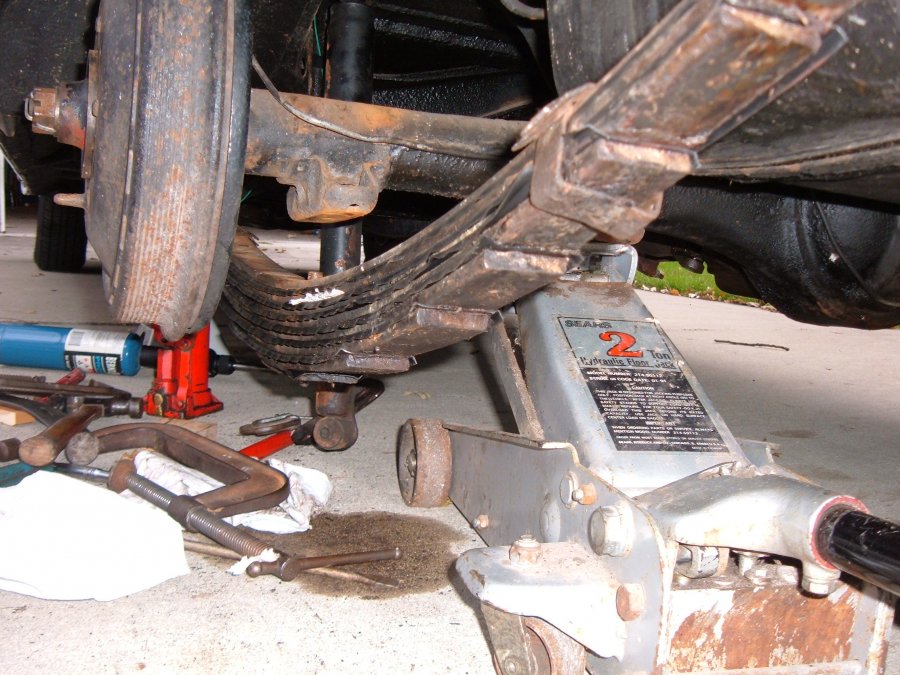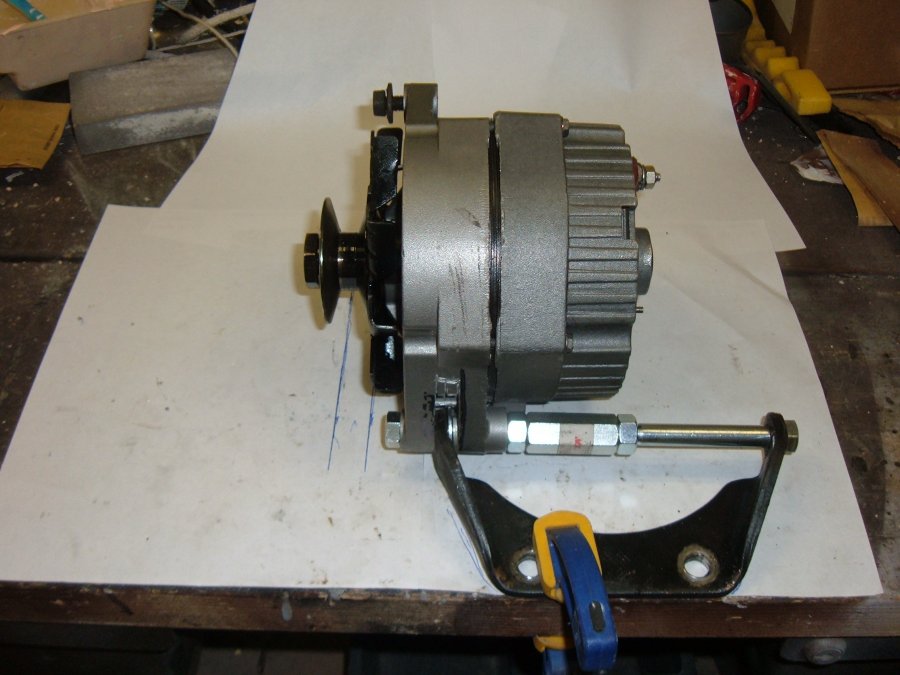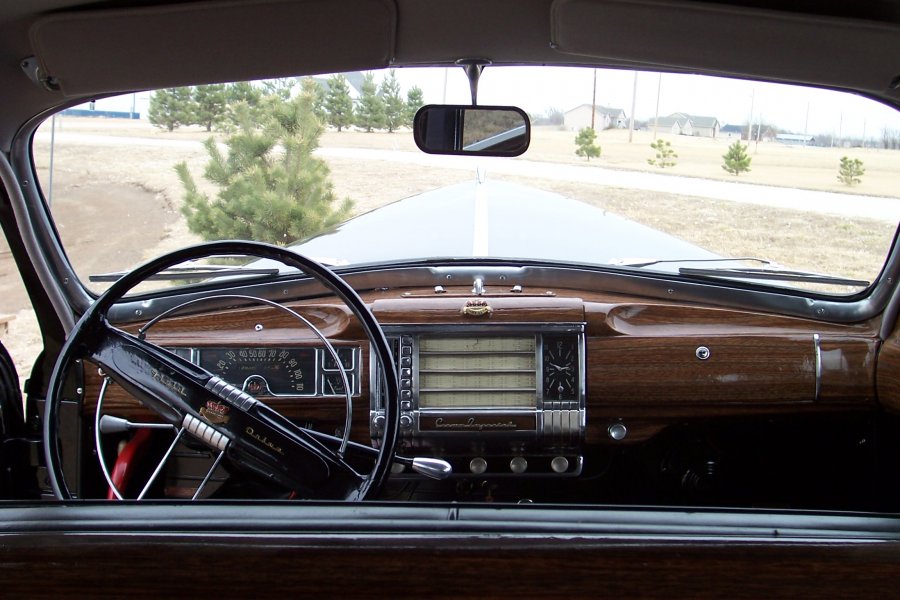-
Posts
2,471 -
Joined
-
Last visited
-
Days Won
25
Content Type
Links Directory
Profiles
Articles
Forums
Downloads
Store
Gallery
Blogs
Events
Everything posted by DonaldSmith
-
Never had the lead spring wrappings. Springs squeaked. Disassembled and greased the springs; squeaks came back. Then I bought spring liners from one of the on-line speed shops. Photo shows the liners in place as I was adding lowering blocks.
-
The basics is the connection of the cables to the battery. Positive ground, cable from (+) post to engine block. Negative ground, cable from (-) post to block. The wiring loom doesn't know the difference. Certain polarity-sensitive accessories, like the radio, will know. The coil shoild have the polarity as marked. This may be an oversimplification, but it's the place to start.
-
Adding another alternator would require some pulley and belt work, just as adding power steering or air conditioning. It could be done, and has been done. Electrically, I don't see a problem with a separate 12-volt system. But maybe could use a 6-volt to 12-volt inverter to power the electronics, if they do not draw too much current. Remember that the 6-volt side would require more than double the amperage of the 12-volt side, so you would need adequate wiring and fuse or breaker. I had a 12-volt pusher fan and a jury-rigged second battery to get the 12 volts. I replaced the pusher fan with a 6-volt unit, and deleted the second battery. Then I added an inverter for cellphones, GPS devices, etc. So far, so good.
-
The diagram does not show power to the dimmer switch. (Maybe it's understood; existing power circuit.)
-

Lead substitute vs upper cylinder lubricant
DonaldSmith replied to Dennis Detweiler's topic in P15-D24 Forum
I still have the bottle of lead substitute that I bought 15 years ago when I first got my 47 DeSoto. (Newby exuberance - buy whatever the car might need.) Then I read on this forum that the valve seats are hardened, and these engines don't need Ethyl gas, or a lead substitute. -
Deep in our family history is the tale of the time our father ran out of gas in his 47 DeSoto Suburban full of kids. We were traveling at night, and the nearest gas station was closed. My dad borrowed a small, enameled potty chair, and headed to the station. He returned with the potful of the necessary essence to get the car running. Then he proceeded to the station, and since the pump was left on, he filled the tank. Being an honest man, he slipped the dollar and change under the door of the station.
-
You guys are scaring me. I put a Pertronix system in my 47 DeSoto; so far, so good. But any moment, when we're far from home... When I installed the Pertronix system, I added a junction block to the inside fender, near the distributor, and I drew diagrams of how to connect the points-type ignition vs. the Pertronix system. Fine, but I dread having to redo the everything along the side of the road, including setting the timing. Maybe I'll just buy an extra Pertronix Ignitor.
-
Maybe you would want to cushion the wall, so you can push the car all the way against the wall.
-

What some of us got up to in England, today
DonaldSmith replied to Robin (UK)'s topic in P15-D24 Forum
It looks like all the steering wheels are on the left. Don't stick out your arm if you are close to the curb. (kerb?) Are these all, or most of them, imports from the States? (States: Canadian shorthand for the United States of America. What do the Brits call the USA, politely, of course?) -
Old Bob Hope joke, or so I was told. He asks one of the women on the tour to put her hand in his pocket. She says, "Oh, I'd feel crazy." He says, "Put your hand in further (farther?*) and you'll feel nuts". Maybe we all need our own corner. *Farther, a matter of distance; further, a matter of degree. Take your pick.
-
Hey, that Dodge is a Town Sedan, of which we have spoken recently.
-
I've heard of giving up one's life for a friend, but nuts? That's just nuts. Andy, show me the corner; I have to go there.
-
So that's why I can't turn my engine by pulling on the fan blades, even with the plugs out! To move the engine to top dead center, I had to remove the screen from the bell housing and put a pry bar to the flywheel teeth.
-
I looked in the "electrical" section of the shop manual for my DeSoto, but didn't find a step-by-step procedure for "generator not charging". Instead it talks of a generator bench test, and various tests for the regulator. Some experts will have to chime in here.
-
Has your ammeter been working? Headlignts on, needle goes negative. Assuming the motor is running above idle, the generating system should start to move the needle back to neutral. If the battery is not fully charged, and the headlights are off, the needle should show positive, until the battery is more fully charged.
-
Part of your "H" pattern is working. Second Gear is Up, and Third Gear is Down. That part of the linkage is working. That's the control rod that works the forward lever at the transmission. You pull the gearshift toward you, and you think you should get Reverse at Up and First Gear at Down. But the linkage is not transferring that back-and-forth motion to the transmission. Something from your motor mount work or rubber bushing work may have thrown the selector rod and linkage enough out of adjustment. Loosen or disconnect the selector rod at the steering column, and manually push the rod so that the "C" shaped lever at the transmission is as far back as it goes, engaging Reverse or First. How far off is the upper end of the rod from the rest of the linkage? Is it possible that the selector rod got bent, which would shorten it? Has the location of the transmission to the steering column changed? In cases like this, the solutions are elusive, but finally found to be something simple. Good Luck. (I just noticed something in the instructions for adjusting the selector rod: The transmission should be in neutral, while taking the slack out of the selector rod. At the transmission, check that the "C"shaped lever is truly in the neutral position. Just one more thing to check .)
-
Ground the coil separately? But wait! Remember, the Pertronix circuit is backwards from the usual breaker-point circuit. Assuming you still have positive ground wiring: The hot wire from the ignition goes to the (-) post of the coil. The coil is grounded from its (+) post to the distributor. The points ground the circuit. Points close,. coil energized. Points open, zap.
-
Oops; disoriented. You are holding your distributor about a quarter turn from mine. OK, start with the straps, at 10:30 and 4:30 in your photo.. In your photo, at 9:00, is where the external wire connects. Attach one end of your loose black wire to the open screw hole. Connect the other end of that wire to the screw where the flat springs from the points are connected; we see the side of that screw. The red wire from the condenser has to attach to the points somewhere there. My photo shows the strap between the components there. The flexible wire which is already in place grounds the moving distributor plate to the distributor body. I hope this answer is quick enough for you. I type faster than I should, and have to go back and fix the typoooos.
-
We'll try: Your red condenser wire goes where the blue-sheathed strip goes, to the points. The loose flexible black wire connects the distributor plate to ground. Your in-place flexible wire connects the outside wire to the moving part of the points. Points closed, coil grounded. Points open, coil generated high voltage for spark.
-
The bracket shown provides the offset for the alternator . I reused the stock generator bracket, but I had to cut a notch in my alternator. It works. For 49 bucks or so for that bracket, you won't have to fuss.
-
Town sedans don't have the rear quarter window that was common with the typical sedans of the era. The B pillar is farther back than typical, and the doors are wider, besides the rear door being front-hinged. At the Orphan car show yesterday, I saw a '37 Cord and a Graham Hollywood, which shared the same body, with the Hupmobile also. The rear doors are front-hinged, like a town sedan, but the front doors are rear-hinged.
-
Going to the Orphan Car Show in Ypsilanti, MI, tomorrow. It's put on by the Ypsilanti Auto Museum, a former Hudson dealership. My DeSoto is an orphan, as are Plymouths, and branded Imperials. Chrysler imperials are not considered orphans. Chevrolet Corvairs are allowed, because they were made in Ypsilanti. Longstanding orphans are Hudsons, Studebakers, Nashes and Packards. Recently orphaned brands such Oldsmobiles and Pontiacs have to be at least 20 years old. Great show, and I'll hang out with the DeSoto people. Fees go to the non-profit museum.
-
That's the one (and maybe the only one). Notice that the rear doors have their own locks, possibly keyed separately .... don't want the hired help getting into the good stuff.
-
Is the old tractor mechanic an old man who works on tractors, or a man who works on old tractors, or both? (I'm guessing both.)
-
So, it looks like Possibility No. 3: One-off for Chrysler executive. Now, I'm wondering how much Briggs had to do with prototypes and one-offs. I suppose that for the Chrysler limo/town sedan, Briggs furnished the body complete with custom interior and limo divider, as they had the parts or could source them. I found photos in line for a 1942 Chrysler limo with a one-piece curved windshield. That probably was a one-off, something that Briggs played with, getting prepared for the future.






